REVIEW: Augustana Musical Theater Prof Offered a Wonderful Time in Personal “Mary and Ethel” Tribute
You know when they say film versions of stage plays often “open them up” with exterior settings or other visual changes that are not possible

Shelley Cooper and Mason Moss in “Mary and Ethel: How I Learned to Sing.”
or feasible in a theater?
Well, two already remarkable stage shows at this month’s Mississippi Bend Players – the top-notch professional summer stock at Augustana College – have benefitted from that approach, both without leaving an indoor theater.
Just a week after its first 2021 production, “Red” (which premiered in 2012 at QC Theatre Workshop), MBP again transformed the Brunner Theatre Center into a spacious, sophisticated cabaret with Shelley Cooper’s heartfelt, deeply personal one-woman show, “Mary and Ethel: How I Learned to Sing.”
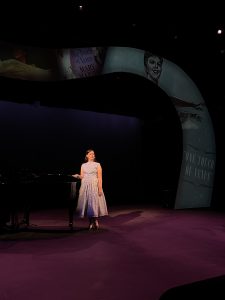
Projections played a large part in “Mary and Ethel” at Brunner Theatre, Augustana College, Rock Island.
The panoramic, highly entertaining production – that debuted at the Circa ‘21 Speakeasy in September 2020, contains 26 classic musical numbers from musical theater Golden Age icons Mary Martin (1913-1990) and Ethel Merman (1908-1984).
Though unfortunately not a ton of people came to see it during its four-performance run, this “Mary and Ethel” (like the two-man “Red” before it) was a super-sized version of its former self.
With pitch-perfect arrangements and piano accompaniment by Quad-City music director Mason Moss, Cooper sang multiple medleys from Broadway hits like Anything Goes!, Hello, Dolly!, The Sound of Music, South Pacific, Annie Get Your Gun, Peter Pan and more, as well as offering many revealing tidbits about
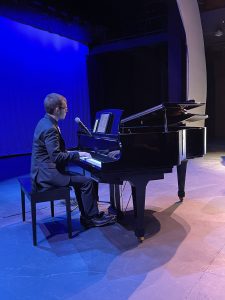
Pianist and music director Mason Moss co-created and did the arrangements for “Mary and Ethel.”
the legendary women’s histories and Cooper’s own.
The contrasting two-act structure (co-created with Moss) positioned the first half with 12 numbers made famous by the more demure, lovely and vulnerable Martin, and the second half with 14 from the bigger, tougher and brassier Merman – Cooper at one point compared Mary’s voice to an oboe and Ethel to a trumpet, and you could tell the stylistic difference right from the start of the second act.
Compared to the smaller Speakeasy venue, the Brunner offered much greater possibilities – mainly in varied visual format – while Cooper did add two Rodgers and Hart songs (the standards “My Funny Valentine” and “Where or When”) to the first half, and she also added a lot of her childhood stories that weren’t shared at the Speakeasy.
Cooper – Augustana assistant professor of musical theatre — has been performing and interested in theatre since childhood, and during “Mary and Ethel: How I Learned to Sing,” she spoke movingly of how both Martin and Merman influenced her relationship with musicals. Her passion and enthusiasm for theater (from such a young age) is simply infectious, both in songs and speech.
Beyond her overpowering, impressive, self-assured vocal technique, the visual flair of the MBP revue was a perfect complement to help Cooper tell her inspiring story.
Scenic designer (and lighting designer) Cameron L. Strandin created a unique, wavy framing backdrop – which not only served as a kind of
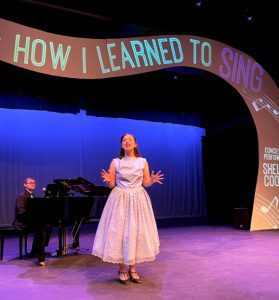
Cooper performed 12 songs made famous by Mary Martin, starting with “A Wonderful Guy.”
swooping proscenium, but the screen on which projections designer Roger Pavey Jr. expertly displayed a panoply of matching photos, videos, logos, album covers and other art.
Rather than working with a traditional rectangular screen, Pavey somehow projected the many images to perfectly match the thin shape of the Brunner set piece. It was mind-blowing, in part because for each song, the backdrop would feature multiple images, reflecting one show, for
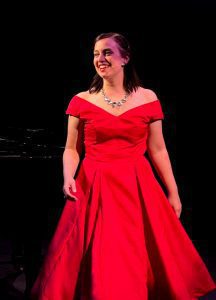
Cooper noted that Ethel Merman lost the Tony Award for Best Actress in “Gypsy” to Mary Martin in “The Sound of Music.”
example, plus appropriate musical staffs.
The timing of the images (including several of a cute Cooper as a variety of costumed characters as a kid) was also impeccable from start to finish.
After her exuberant, expressive “A Wonderful Guy” to open the show, the last chord was accompanied by the visual logo for her show across the projected area, and as Cooper took her bows at the very end, her arm gestures exactly matched those in brief video of Martin and Merman. That is stunning attention to detail.
What seemed clear in the connection among the three women – the two Broadway stars and the great Broadway interpreter – is that Martin, Merman and Cooper have always been up for a theatrical challenge and more than equal to the daunting task.
That included Cooper in second grade creating her first one-woman show, for “Rabbit No. 2” from “The
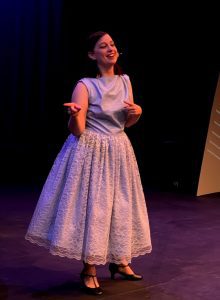
Cooper said the first live musical she ever saw was “Peter Pan” (starring Cathy Rigby), the role originated by Mary Martin.
Velveteen Rabbit,” and later in school playing the gender-bended roles of King Arthur, Pinocchio and Scarecrow (from “Wizard of Oz.”
In Martin’s case, she scaled the musical mountains of flying as Peter Pan (the boy who wouldn’t grow up) and shampooing her hair onstage for 1,200 performances in “South Pacific” during “I’m Gonna Wash That Man Right Outta My Hair.”
Cooper justifiably marveled at the composers who wrote shows specifically for Mary and Ethel – Rodgers and Hammerstein penning Nellie in “South Pacific” and Maria in “Sound of Music,” just for Martin. Cole Porter penned five shows for Merman, as well as George Gershwin writing “I Got Rhythm” (1930) for her; Irving Berlin creating “Annie Get Your Gun” (1946) and Jule Styne and Stephen Sondheim writing “Gypsy”
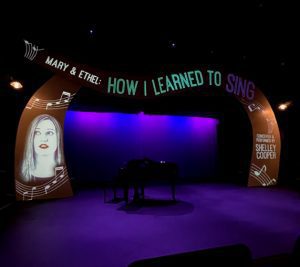
The set and lighting design were led by Cameron L. Strandin and projections designer was Roger Pavey Jr.
(1959) for her.
Before belting out the brassy anthem “Everything’s Coming Up Roses,” Cooper called Mama Rose of “Gypsy” the “King Lear of musical theater roles,” and noted that Merman lost the Tony for Best Actress to her friend Martin, and jokingly quipped about the wholesome, beloved Maria – “How are you gonna buck a nun?”
After the titanic dramatic role of Mama Rose, Jerry Herman wrote “Hello Dolly” for Merman, which premiered in 1964 with Carol Channing. Merman didn’t play it until the end of its long run (in 1970), which Cooper said was to be three months and turned into nine months.
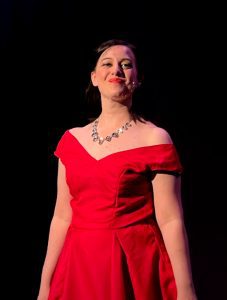
Shelley Cooper performed 14 songs made famous by Ethel Merman.
With “Mary and Ethel,” the multi-talented singer, director, choreographer and teacher made a massive amount of intensely covered music seem fresh, effortless and utterly absorbing.
Cooper’s Martin repertoire was sensitive, sunny and gorgeous, while the Merman half was definitively more brash, domineering and sassy – which reflected the women’s true personalities.
Even in the gentle, wistful “But Not for Me,” as Ethel, Cooper gave the ballad a sharper, bright, harder edge than usual, but she dialed it back with fitting nuance and lyricism in the beautiful “They Say It’s Wonderful” and “I Got Lost in His Arms.”
While Moss displayed virtuosic accompaniment, including some showy solos, his banter and occasional
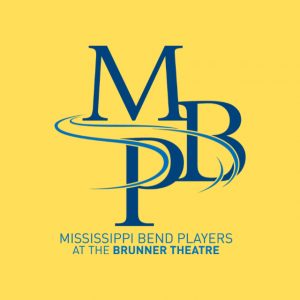
The Mississippi Bend Players last show this summer is “No Child…” July 8-11.
singing with Cooper felt a bit flat and forced. His mic seemed to work fine for his spoken parts, but not so much for his singing in “Anything You Can Do,” and Cooper’s body mic seemed both unnecessary and unnoticed. Her powerful soprano doesn’t need amplification for audiences of well under 50.
Outside of performance, Cooper has most recently directed Beehive at Circa ‘21, Into the Woods at Augustana College and also has another original one-woman operatic show, La Divina: The Last Interview of Maria Callas (which went unmentioned here).
After performing it in late May at the Orlando Fringe festival in Florida, the 35-year-old Louisville native earned the Orlando Fringe Critic’s Choice for Best Individual Performance, Drama, for “La Divina.”
What made “Mary and Ethel” so affecting also was Cooper’s attention to gesture, movement and facial expression that fit succinctly and securely for each song. The dreamy magic of “Never Never Land” is not just in the idealistic words and music, and starry backdrop, but in her bright smile, her searching eyes and her whole poised being, for example.
You can tell she’s a veteran choreographer and director, and she’s achieved great success performing around the world. We are so lucky to have Shelley in the Quad-Cities.









